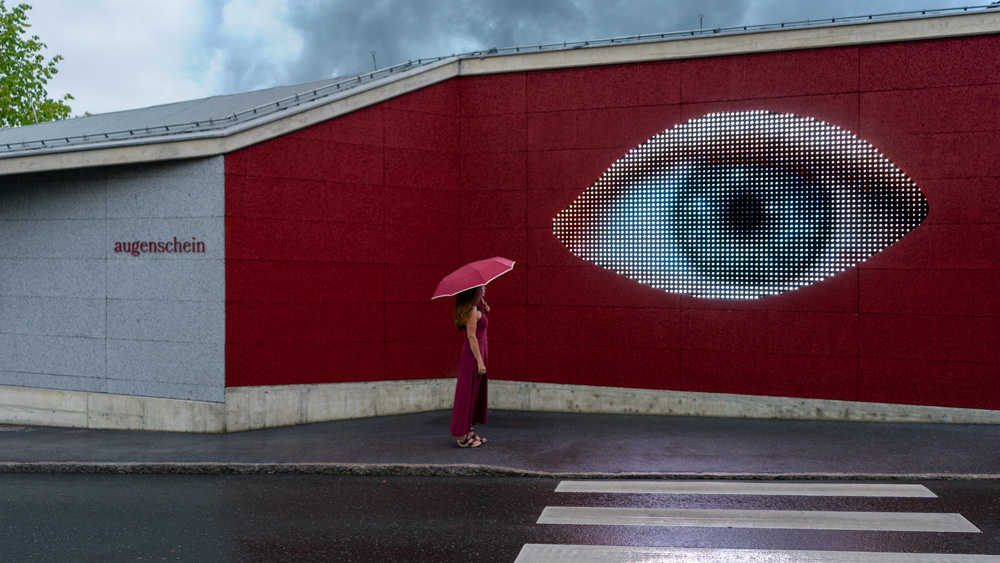
Augenschein, installation view
Augenschein
— a light installation for the Stieglerhaus, St. Stefan ob Stainz, AT
The eye has always played a vital role in human history, whether as the organ of vision or as a pivotal cultural symbol in the arts of all ages. In digital and new media art in particular, it becomes a “third eye”, that is, the camera that translates electromagnetic stimuli into perceptions of light that give shape and colour, not unlike the sensory organ itself.
“Augenschein” is a public art project that takes the eye as a symbol for how our society relates to vision and visualisation, both in its encouraging perspectives as well as its more dangerous aspects to which we mustn’t turn a blind eye. When we pass by Sylvia Eckermann’s artwork, we look at eyes but at the same time they look back at us, echoing the liveliness, the animation and the anxiety of the human gaze as well as its imprints on our sociality and communality. On the one hand, the eye – appearing both in the artwork and in its title – becomes the emblem of an open society in which we may look at and recognise each other. At the same time, the artwork faces up to a reality in which we are being observed, monitored and controlled – in the famous words of the American poet Richard Brautigan, “all watched over by machines of loving grace.”
The artwork is installed on the outside wall of the cultural centre Stieglerhaus, facing the main street of St. Stefan ob Stainz in Western Styria. Composed of video recordings of human eyes, the artwork confronts the rural village with an allegory of a culture shaped and informed by visibility and transparency. Realised as a filmic sequence, it also points to its material and technical substrate, video, a Latin term which literally means “I see”. And while seeing is a cultural technique that offers myriad interpretations and applications, the title “Augenschein” refers especially to optical sensations and appearances as well as to consideration and the cognition of an object or event in the legal sense.
Seeing is the paradigmatic sense of our time but seeing is not an objective process. It is influenced by our beliefs and ideas, conventions and morals, norms and objectives, interests and suppressions, memories and fantasies. At the same time, the eye and the sense of seeing are vital for the socio-cultural process we call individualisation. The “power of the eye” incarnates a host of different senses among which meanings can be far apart like the curiosity (“Schaulust” in German) to experience the world, the visualisations of science and technology and the reveries and revelations of one’s innermost thoughts. The eye represents consciousness and insight, providence and embracing love, but also voyeurism, superstition and possession. The eye is a symbol for the enlightenment, the sciences and progress as well as for fantasies of omnipotence and conspiracy theories. Metaphorically, it stands for the all-seeing eye of God as well as surveillance technologies, for vigilance and focusing on the basics as well as the beauty of the visible world.
“Augenschein” as a public art installation has the form of an eye cut out of insulation panels on a wall and a low-resolution LED mesh behind it. Thus, the video appears as a pixelated image at close range while it becomes an intriguing filmic sequence from further afar in which the looped video composition changes from one eye to the next with every twinkle. The eyes Sylvia Eckermann filmed for her artwork belong to mainly village residents, to people of different ages and ethnicities – a collection of “portraits” the artist put together in order to interrelate the artwork to the specific site of its public presentation. Hence, the artwork does not only communicate with the residents of St. Stefan ob Stainz, they are genuinely part of it. Passing by, they might wonder which eye is theirs or they might even recognise it. And as the residents “look” observingly at their village by day and night and also when they actually go to watch the artwork, the public art project becomes a symbol of belonging and the ties as well as densities within a community.
Sylvia Eckermann, Augenschein, 2020. video documentation
Additional credits:
LED Mesh Screen: LDDE Lighting Ideas Vienna AT.
Production: Bela Eckermann
The Stieglerhaus is a place of personal encounter and communication. On the basis of humanism, cosmopolitanism and respect we offer art, education, culture and entertainment "from society for society."
St. Stefan Ob Stainz 14, 8511 St. Stefan ob Stainz. stieglerhaus.at